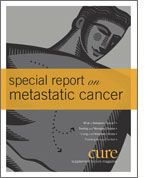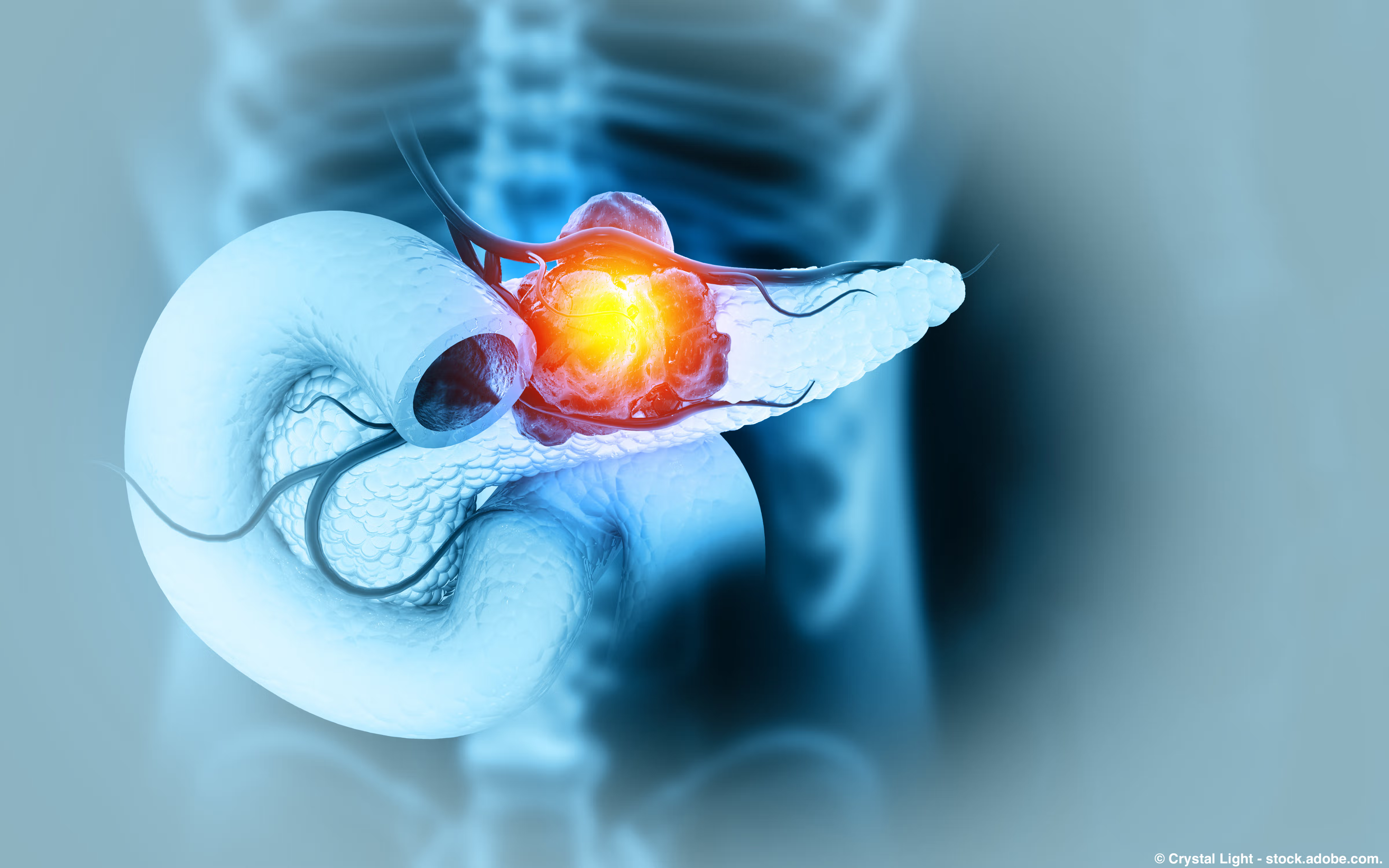Publication
Article
CURE
Living with Metastatic Illness
Author(s):
Quality Control: Even with metastatic cancer, many patients live long and well.
Diane Klenke thought she was dealing with a bout of the flu, when she finally went to see her doctor about a persistent stomachache. She was completely unprepared for the news she had stage 4 pancreatic cancer that had metastasized to her liver.
In her initial visit, she was told that she might only have three months left to live. But that was in February 2004, and today, the 54-year-old Green Bay, Wis., resident has clearly survived long past her initial prognosis and has enjoyed a high quality of life, despite living with metastatic cancer.
“I learned to be my own advocate, fighting for the care I needed and requiring doctors to answer the ‘whys’ and ‘how it works’ questions,” Klenke says. “It made me feel like I had some input, some control.”
Scientific advances and improved therapies have extended survival for many, and newer treatments are better focused with fewer side effects. However, disease symptoms and treatment side effects can still negatively impact a patient’s quality of life.
Klenke credits her success to a rigorous treatment regimen of chemotherapy, integrative therapies, a strong support system and faith. Her symptoms to date have been minimal and controllable. “As a result of the intense chemotherapy, I became a type 2 diabetic,” she says. “But a couple of prescriptions, great diet and exercise keep me in normal ranges.”
Mild swelling in her feet and lower legs that occurred during treatment was improved, she says, by increasing her protein intake.
In addition to drug-related side effects, patients with metastatic disease may also be dealing with cancer-related pain, bone weakness and fatigue, as well as treatment-related side effects, such as nerve damage and gastrointestinal issues.
Cancer-related pain may be caused by the tumor itself or by the treatment, and it remains one of the most common symptoms experienced by patients with metastatic disease, affecting more than three-fourths of all individuals at some point.
“Nearly all cancer patients [with significant pain] should be on a long-acting drug to help manage it and a short-acting drug for breakthrough pain,” says Thomas J. Smith, MD, director of palliative medicine at Johns Hopkins Sidney Kimmel Comprehensive Cancer Center in Baltimore. “And patients should see a pain or palliative care specialist if their pain is not being addressed by their regular provider.”
I learned to be my own advocate, fighting for the care I needed. It made me feel like I had some control.
Numerical rating scales of 0 (indicating no pain) to 10 (indicating the worst pain imaginable) are most commonly used in the initial and ongoing evaluation of pain. Ideally, the pain score should be kept down to 4 on that scale, as patients can function at that level, Smith says.
Regardless of its source, pain treatment usually includes the use of some type of analgesic medication. The World Health Organization’s pain ladder advocates a stepwise approach. Pain relief begins with nonopioids, such as aspirin and acetaminophen, and then progresses as needed to mild opioids, and then stronger ones, such as morphine.
Opioids are effective in controlling pain but can cause side effects—most notably constipation, which occurs in 40 to 70 percent of patients. But preventing constipation in the first place is key, Smith says. “Every good pain drug slows down the colon nerves, which causes constipation,” he says, recommending a fiber-rich diet, plenty of fluids, stool softeners or laxatives, and daily walks.
Osteolytic bone destruction occurs when cancer cells completely destroy the bone in a specific area. Another type of bone metastasis, osteoblastic lesions, occur when cancer cells lead to abnormal calcium deposition on bone tissue.
Because bone metastases can weaken bones, patients are at greater risk for bone breaks, or what is known as “pathological fractures.” In turn, these fractures and the overall weakening of the bones can force patients to be less active, which may lead to chemical imbalances in the blood, including an increase in calcium levels (hypercalcemia). Another less common complication is spinal cord compression, which can cause nerve damage or may progress to paralysis.
Treatment can be multipronged and may include surgery, chemotherapy, hormone therapy, radiation therapy and immunotherapy. Pain can be treated with opioids or other types of medication, and physical therapy and surgery may be part of the treatment plan if fractures have occurred.
Of particular importance are bisphosphonates and RANK ligand inhibitors, a new class of drugs that includes Xgeva (denosumab), that are being increasingly used to reduce the incidence of pain and other complications from bone metastases. There is also some evidence that they may improve the overall health of bones. These so-called bone modifying agents (BMAs) are able to relieve pain caused by both types of lesions, although experts believe these drugs might be more helpful for patients with osteolytic bone damage. BMAs have been associated with increased risk for osteonecrosis (bone death) in the jaws of some patients, a rare but serious side effect known as ONJ.
Fatigue is the most common and pervasive symptom that patients with metastatic cancer experience, and it can stem from both the underlying illness and therapies therapies, such as chemotherapy and radiation. There is no “one-size-fits-all” solution for managing fatigue, says Jennifer S. Temel, MD, assistant professor of medicine at Harvard Medical School and clinical director of thoracic oncology at Massachusetts General Hospital in Boston. Resolving fatigue often requires a careful evaluation of the cancer and the treatment, as well as individual factors, such as anemia, poor nutrition, lack of physical activity, disrupted sleep and emotional distress that can all cause or worsen fatigue.
Stimulants, such as methylphenidate and modafinil, can help patients dealing with severe fatigue. More recently, a study found that 2,000 milligrams a day of American ginseng helped improve fatigue without any known side effects. Non-drug solutions include exercise and cognitive-behavioral therapy.
Different treatments cause different side effects, and as patients with metastatic cancer often undergo multiple treatments during the course of many months or years, it is imperative they consider their quality of life when making treatment decisions. It’s important to establish goals, says Charles Loprinzi, MD, a breast cancer specialist at the Mayo Clinic in Rochester, Minn. “Generally, the goal is to do as well as possible for as long as possible.”
We want the least toxicity and fewest side effects. We want patients to have the best quality of life, and we want them to have the longest life.
He advises patients to consider four goals of treatment: “We want the least toxicity and the fewest side effects. We want patients to have the best quality of life, and we want them to have the longest life.”
Nerve or neuropathic pain (neuropathy) is usually treatment-related and may be treated with anticonvulsants or antidepressants because of their effects on certain brain chemicals. Thus far, Cymbalta (duloxetine) is the only drug to show promising results in helping chemotherapy- induced peripheral neuropathy. The most important thing is to see a nerve specialist or pain specialist and be persistent, Smith says. “You may need to try several drugs before finding one that helps.”
Side effects related to the digestive system, including nausea, vomiting, diarrhea and oral mucositis, are also frequent side effects of treatment. A number of antinausea medicines (antiemetics) are currently available, including ondansetron, granisetron, Aloxi (palonosetron), Anzemet (dolasetron) and aprepitant. Non-drug strategies, including acupuncture and relaxation techniques, can also help relieve symptoms, as can changes in diet, such as eating before treatment begins and consuming foods that do not trigger nausea.
[Read "Advancements in Supportive Care"]
Diarrhea can often be treated by a change in medications or diet (eating small, frequent meals and avoiding spicy foods), or drugs to slow bowel activity
Oral mucositis, a painful inflammation and ulceration in the mouth, can make it difficult to eat and drink, or even speak. Mucositis is usually treated by relieving pain with analgesic mouth rinses that contain lidocaine plus antibiotics and anti-inflammatory drugs. Eating ice chips 30 minutes prior to and during chemotherapy may decrease the severity of oral mucositis and the resultant pain.
Klenke changed her traditional meat and potatoes diet to one rich in fresh vegetables and fruit, and some fish. She removed dairy, meat and sugar, and also used supplements prescribed by her physicians. When treatment results weren’t as good as hoped for, she used breathing exercises to help her relax and reduce stress, and visualization techniques to “picture” her tumor shrinking. She credits her dietary changes and supplements for helping enhance the effects of chemotherapy. Integrative therapy is becoming more widespread in cancer care, be it mediation, yoga, acupuncture or aromatherapy. “But with the advancement of science, we now understand exactly why and how these therapies work,” says Sarah Rausch, PhD, executive director of the Society for Integrative Oncology. “We can understand the mechanisms of action and better understand which therapies are safe and beneficial for which patients.”
We can understand the mechanisms of action and better understand which therapies are safe and beneficial for which patients.
There is scientific evidence, for example, that acupuncture is effective for relieving pain and can help manage some side effects, such as nausea and vomiting. Mind-body therapies, such as relaxation, meditation and music therapy can also be effective in managing pain, as can massage therapy when delivered by a therapist trained in oncology massage, Rausch says.
Smith’s advice to patients is to do “whatever works.” Yoga helps with stress, mood and muscle strength, and other exercise has all the same benefits. American ginseng might help with fatigue, and ginger helps with nausea, he says, and there are often good data from randomized controlled trials to support this.
However, he emphasizes that it is imperative that patients tell their doctors what they are using. “Most of these therapies are safe, but there can be [adverse] interactions with some agents,” Smith says.
You can read more on supportive care in CURE's supplement, "Countering the Effect of Cancer Treatments."





